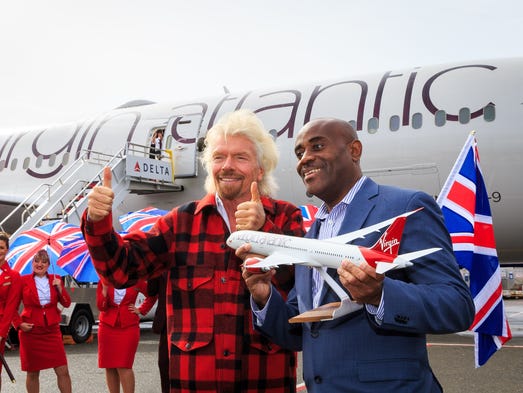Leeham News and Analysis
There's more to real news than a news release.
Pontifications: Branson gets pissy over dropping the Virgin America name

By Scott Hamilton
April 3, 2017, © Leeham Co.: Sir Richard Branson came to Seattle last week to promote the new service by Virgin Atlantic Airlines to London. In a hissy-fit, he promptly pissed on Alaska Airlines for the business decision to drop the Virgin America brand in 2019.
Alaska, of course, acquired Virgin America last year. The acquisition didn’t sit well with Branson, who nevertheless made out well in the deal.
Although Alaska officials said they would decide later whether to retain the Virgin brand, only those with wishful thinking gave any chance of this happening.

Richard Branson in Seattle for Virgin Atlantic’s new service to London. USA Today photo via Google.
Branson certainly knows this. In 1997, Virgin Group acquired the low fare carrier Euro Belgium Airlines for $60m and promptly dropped the name in favor of Virgin Express.
VE lasted only nine years; it ceased operations in 2006 when it was sold and merged into the new Brussels Airlines.
Branson’s whining over Alaska’s decision to operate the merged operations into the Eskimo’s image smacks of hypocrisy.
Let’s also remember that his Virgin Atlantic is 49% owned by Delta Air Lines, which is building a hub in Seattle in competition with Alaska. The fight between Alaska and Delta is sometimes bitter.
Branson’s criticism of Alaska might have as much to do with Virgin Atlantic’s partnership with Delta as it does his own bruised ego.
Pontifications: Warlick’s Warriors support ALS research
March 27, 2017, (c) Leeham Co.: It wasn’t the kind of presentation usually given at the ISTAT general meeting earlier this month. Peter Warlick, vice president of finance for American Airlines, announced to nearly 2,000 people that he has ALS (Amyotrophic Lateral Sclerosis), more commonly known as Lou Gehrig’s disease.

Peter Warlick
ALS attacks the muscular system and is typically fatal within two-five years. There is no cure.
Warlick actually revealed his condition last year, but I missed the announcement in which American also pledged a $1m donation to ALS research.
Although Pete is only a casual business acquaintance, for me, Warlick’s ISTAT announcement hit home. In 2015, a very close friend and

By Scott Hamilton
colleague died of ALS several years after diagnosis. Stan Bump was a neighbor and I served with Stan on the planning commission in the Seattle suburb in which we lived.
Major fleet decisions may not be positive for Airbus, Boeing
Pontifications is off this week.
Subscription Required
Introduction
March 20, 2017, © Leeham Co.: There are some major fleet decisions that will probably come down the pike this year at American, Delta and United airlines. Not all of them are going to be viewed positively by Airbus and Boeing.
 There is also a serious warning sign emerging from the Middle East that could have serious, negative impacts on Airbus and Boeing.
There is also a serious warning sign emerging from the Middle East that could have serious, negative impacts on Airbus and Boeing.
Summary
- American Airlines doesn’t want its Airbus A350-900s any more. Consolidation with US Airways appears to have made these surplus.
- Delta Air Lines, which so far eschewed any orders for the Airbus A320neos and Boeing 737 MAXes, is understood to be readying a Request for Proposals to be issued this year.
- United Airlines doesn’t want its Airbus A350-1000s any more. Picking up cheap Boeing 777-300ERs appear to have made these surplus.
- Emirates Airlines, reacting to Brexit and Donald Trump’s travel bans, is undertaking a full business review in response to a sharp drop in bookings.
Pontifications: Boeing MAX 10, “797” NMA dominated ISTAT headlines

By Scott Hamilton
March 13, 2017, © Leeham Co.: The soft launch of the Boeing 737-10 and the prospective Boeing “797” Middle of the Market aircraft easily were the headline news items to come out of the annual ISTAT conference in San Diego last week.
The “797,” as the MOM-sector aircraft was unofficially dubbed, brought enthusiastic reaction.
The MAX 10, not so much.
If Boeing builds MAX 10, will customers come?
Subscription Required
Introduction
March 7, 2017, © Leeham Co.: If Boeing builds the 737-10, which appears increasingly likely, will customers come?
This is always the multi-billion-dollar question for any aircraft and engine manufacturer.
For Boeing, launching the 737-10 is a low-risk, and in the eyes of many, futile effort to stem the bleeding of market share between the MAX 9 and its rival, the Airbus A321neo.
- “That’s the most absurd thing I’ve ever heard. What is he, flying downhill?” Airbus’ John Leahy reacting to claims by Boeing’s Randy Tinseth that the 737-10 has more range than the A321neo.
Depending on who’s counting and how the numbers are calculated, the A321 sales outpace the MAX 9 by a factor of four or five to one. LNC calculated last year that the ratio is more likely 3:1, identical to the market share split between the predecessor airplanes, the 737-900ER and the A321ceo.
Pontifications: Boeing 737-9 roll-out–Nothing Special in the Air
March 6, 2017, © Leeham Co.: Boeing rolls out its 737-9 MAX tomorrow.
Last week, I received a call from one of the network/cable news organizations asking, What’s special about this airplane?
The answer is: Nothing.
Long, bitter history precedes union vote at Boeing Charleston today
Feb. 15, 2017, © Leeham Co.: Boeing’s touch-labor workers at its 787 assembly plant in North Charleston (SC) will vote today on whether to become represented by  the International Association of Machinists (IAM).
the International Association of Machinists (IAM).
It’s a vote with huge stakes for both sides.
Boeing vociferously opposes a Yes vote. The IAM, which represented workers on the property when it was owned by Vought before Boeing purchased the plant, was voted out by the workers, by then employed by Boeing, just days ahead of Boeing selecting Charleston for the second 787 assembly line. It is widely believed the vote throwing out the IAM was the capper in Boeing’s decision to locate line 2 in Charleston.
The IAM has been itching ever since to regain representation of the workers here. A previous vote was scrubbed when it became clear, via nose-counting, it would fail.





Norwegian, others have vision; US airlines don’t
Subscription Required
Introduction
Dec. 5, 2016, © Leeham Co. Last weeks’ approval by the US Department of Transportation of a license for Norwegian Air Shuttle to operate long-haul, low-cost service to and from the US drew immediate fire from labor unions over anticipated US job losses.
Iceland’s Loftleider Airlines, one of the first trans-Atlantic low-cost carriers. Photo via Google images.
But their view is too narrow.
It means more jobs for Boeing and its supply chain, which are also heavily unionized. It means benefits to US exports.
But overlooked is the next evolution in long haul travel that starts next year.
Summary
Read more
Leave a Comment
Posted on December 5, 2016 by Scott Hamilton
Airbus, Airlines, American Airlines, Boeing, Delta Air Lines, Emirates Airlines, Leeham News and Comment, Premium, United Airlines
737-8, 737-800, 737-9, 737-900ER, 767, 787, A321LR, A321NEO, A330, Airbus, American Airlines, Boeing, Delta Air Lines, Icelandair, Laker Airways, Loftleider, SkyTrain, United Airlines